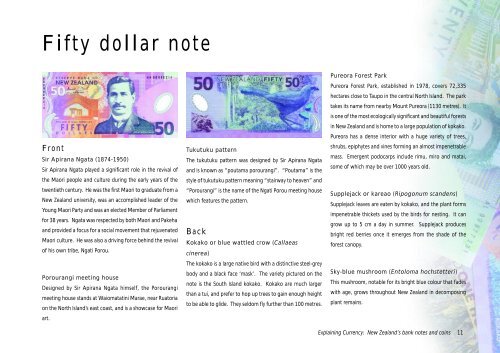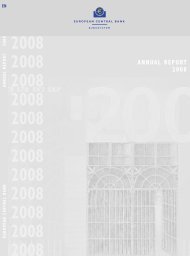Explaining Currency: New Zealand's bank notes and coins
Explaining Currency: New Zealand's bank notes and coins
Explaining Currency: New Zealand's bank notes and coins
Create successful ePaper yourself
Turn your PDF publications into a flip-book with our unique Google optimized e-Paper software.
Fifty dollar noteFrontSir Apirana Ngata (1874-1950)Sir Apirana Ngata played a significant role in the revival ofthe Maori people <strong>and</strong> culture during the early years of thetwentieth century. He was the first Maori to graduate from a<strong>New</strong> Zeal<strong>and</strong> university, was an accomplished leader of theYoung Maori Party <strong>and</strong> was an elected Member of Parliamentfor 38 years. Ngata was respected by both Maori <strong>and</strong> Pakeha<strong>and</strong> provided a focus for a social movement that rejuvenatedMaori culture. He was also a driving force behind the revivalof his own tribe, Ngati Porou.Porourangi meeting houseDesigned by Sir Apirana Ngata himself, the Porourangimeeting house st<strong>and</strong>s at Waiomatatini Marae, near Ruatoriaon the North Isl<strong>and</strong>’s east coast, <strong>and</strong> is a showcase for Maoriart.Tukutuku patternThe tukutuku pattern was designed by Sir Apirana Ngata<strong>and</strong> is known as “poutama porourangi”. “Poutama” is thestyle of tukutuku pattern meaning “stairway to heaven” <strong>and</strong>“Porourangi” is the name of the Ngati Porou meeting housewhich features the pattern.BackKokako or blue wattled crow (Callaeascinerea)The kokako is a large native bird with a distinctive steel-greybody <strong>and</strong> a black face ‘mask’. The variety pictured on thenote is the South Isl<strong>and</strong> kokako. Kokako are much largerthan a tui, <strong>and</strong> prefer to hop up trees to gain enough heightto be able to glide. They seldom fly further than 100 metres.Pureora Forest ParkPureora Forest Park, established in 1978, covers 72,335hectares close to Taupo in the central North Isl<strong>and</strong>. The parktakes its name from nearby Mount Pureora (1130 metres). Itis one of the most ecologically significant <strong>and</strong> beautiful forestsin <strong>New</strong> Zeal<strong>and</strong> <strong>and</strong> is home to a large population of kokako.Pureora has a dense interior with a huge variety of trees,shrubs, epiphytes <strong>and</strong> vines forming an almost impenetrablemass. Emergent podocarps include rimu, miro <strong>and</strong> matai,some of which may be over 1000 years old.Supplejack or kareao (Ripogonum sc<strong>and</strong>ens)Supplejack leaves are eaten by kokako, <strong>and</strong> the plant formsimpenetrable thickets used by the birds for nesting. It cangrow up to 5 cm a day in summer. Supplejack producesbright red berries once it emerges from the shade of theforest canopy.Sky-blue mushroom (Entoloma hochstetteri)This mushroom, notable for its bright blue colour that fadeswith age, grows throughout <strong>New</strong> Zeal<strong>and</strong> in decomposingplant remains.<strong>Explaining</strong> <strong>Currency</strong>: <strong>New</strong> Zeal<strong>and</strong>’s <strong>bank</strong> <strong>notes</strong> <strong>and</strong> <strong>coins</strong> 11





![KNOW YOUR NEW GIBRALTAR BANKNOTES - [Home] bThe/b](https://img.yumpu.com/50890985/1/184x260/know-your-new-gibraltar-banknotes-home-bthe-b.jpg?quality=85)
![PAPUA NEW GUINEA - [Home] - Polymer Bank Notes of the World](https://img.yumpu.com/49758743/1/190x143/papua-new-guinea-home-polymer-bank-notes-of-the-world.jpg?quality=85)









